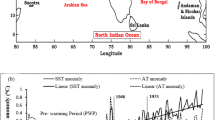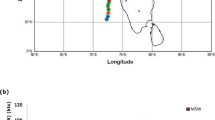Abstract
Research efforts focused on assessing the potential for changes in tropical cyclone activity in the greenhouse-warmed climate have progressed since the IPCC assessment in 1996. Vulnerability to tropical cyclones becoming more pronounced due to the fastest population growth in tropical coastal regions makes it practically important to explore possible changes in tropical cyclone activity due to global warming. This paper investigates the tropical cyclone activity over whole globe and also individually over six different ocean basins. The parameters like storm frequency, storm duration, maximum intensity attained and location of formation of storm have been examined over the past 30-year period from 1977 to 2006. Of all, the north Atlantic Ocean shows a significant increasing trend in storm frequency and storm days, especially for intense cyclones. Lifetime of intense tropical cyclones over south Indian Ocean has been increased. The intense cyclonic activity over north Atlantic, south-west Pacific, north and south Indian Ocean has been increased in recent 15 years as compared to previous 15 years, whereas in the east and west-north Pacific it is decreased, instead weak cyclone activity has been increased there. Examination of maximum intensity shows that cyclones are becoming more and more intense over the south Indian Ocean with the highest rate. The study of the change in the cyclogenesis events in the recent 15 years shows more increase in the north Atlantic. The Arabian Sea experiences increase in the cyclogenesis in general, whereas Bay of Bengal witnesses decrease in these events. Shrinking of cyclogenesis region occurs in the east-north Pacific and south-west Pacific, whereas expansion occurs in west-north Pacific. The change in cyclogenesis events and their spatial distribution in association with the meteorological parameters like sea surface temperature (SST), vertical wind shear has been studied for Indian Ocean. The increase in SST and decrease in wind shear correspond to increase in the cyclogenesis events and vice versa for north Indian Ocean; however, for south Indian Ocean, it is not one to one.








Similar content being viewed by others
References
Anthes RA (1982) Tropical cyclones: their evolution structure and effects. Meteorological monograph No. 41, Am Meteorol Soc, 208 pp
Anthes RA, Corell RW, Holland G, Hurrell JW, Mac Cracken MC, Trenberth KE (2006) Comments on hurricanes and global warming–potential linkages and consequences. Bull Amer Met Soc 87:623–628
Chan JCL, Liu KS (2004) Global warming and western North Pacific typhoon activity from an observational perspective. J Clim 17:4590–4602
Chu PS, Clark JD (1999) Decadal variations of tropical cyclone activity over the central North Pacific. Bull Amer Met Soc 80:1875–1881
Diaz HF, Pulwarty RS (Eds.) (1997) Hurricanes—Climate and socioeconomic impacts. Springer, New York, 292 pp
Elsner JB, Kocher B (2000) Global tropical cyclone activity: a link to the North Atlantic Oscillation. Geophys Res Lett 27:129–132
Elsner JB, Kossin JP, Jagger TH (2008) The increasing intensity of the strongest tropical cyclones. Nature 455:92–95. doi:10.1038
Emanuel KA (1987) The dependence of hurricane intensity on a climate. Nature 326:483–485
Emanuel KA (2005a) Increasing destructiveness of tropical cyclones over the past 30 years. Nature 436:686–688
Emanuel KA (2005b) Emanuel replies. Nature 438:E13
Evans JL (1992) Comment on “Can existing climate models be used to study anthropogenic changes in tropical cyclone climate?”. Geophys Res Lett 19:1523–1524
Feldstein SB (2002) The recent trend and variance increase of the Annular Mode. J Clim 15:88–94
Gillett NP, Zwiers FW, Weaver AJ, Stott PA (2003) Detection of human influence on sea-level pressure. Nature 422:292–294
Gillett NP, Allan RJ, Ansell TJ (2005) Detection of external influence on sea level pressure with a multimodel ensemble. Geophys Res Lett 32:L19714. doi:10.1029/2005GL023640
Gray WM (1968) Global view of the origin of tropical disturbances and storms. Mon Weather Rev 96:669–700
Gray WM, Landsea CW (1992) African rainfall as a precursor of hurricane-related destruction on the U.S. East Coast. Bull Amer Meteor Soc 73:1352–1364
Gray WM, Landsea CW Jr, Mielke PW, Berry KJ (1993) Predicting Atlantic seasonal tropical cyclone activity by 1 August. Wea Forecast 8:73–86
Gray WM, Landsea CW Jr, Mielke PW, Berry KJ (1994) Predicting Atlantic seasonal tropical cyclone activity by 1 June. Wea Forecasting 9:103–115
Hoerling MP, Hurrell JW, Xu T, Bates G, Phillips A (2004) Twentieth century North Atlantic climate change. Part II: understanding the effects of Indian Ocean warming. Climate Dyn 23:391–405
Holland GJ (1997) The maximum potential intensity of tropical cyclones. J Atmos Sci 54:2519–2541
Holland GJ, Webster PJ (2007) Heightened tropical cyclone activity in the North Atlantic: natural variability or climatic trend? Phil Trans R Soc A 365:2695–2716
Houghton JH, Ding Y et al (eds) (2001) Climate Change 2001. The Scientific Basis, Cambridge University Press, p 881
Hoyos CD, Agudelo PA, Webster PJ, Curry JA (2006) Deconvolution of the factors contributing to the increase in global hurricane intensity. Science 312:94–97
Jones PD, Moberg A (2003) Hemispheric and large-scale surface air temperature variations: an extensive revision and an update to 2001. J Clim 16:206–223
Klotzbach PJ (2006) Trends in global tropical cyclone activity over the past twenty years (1986–2005). Geophys Res Lett 33:10805–10809
Knutson TR, Tuleya RE (1999) Increased hurricane intensities with CO2-induced warming as simulated using the GFDL hurricane prediction system. Clim Dyn 15:503–519
Knutson TR, Tuleya RE (2004) Impact of CO2 induced warming on simulated hurricane intensity and precipitation: Sensitivity to the choice of climate model and convective parameterization. J Clim 17:3477–3495
Knutson TR, Tuleya RE, Kurihara Y (1998) The recent increase in Atlantic hurricane activity: causes and implications. Science 279:1018–1020
Knutson TR, Tuleya RE, Shen W, Ginis I (2001) Impact of CO2- induced warming on hurricane intensities as simulated in a hurricane model with ocean coupling. J Clim 14:2458–2468
Kossin JP, Knapp KR, Vimont DJ, Murnane RJ, Harper BA (2007) A globally consistent reanalysis of hurricane variability and trends. Geophys Res Lett 34:L04815. doi:10.1029/2006GL028836
Kumar A, Yang F, Goddard L, Schubert S (2004) Differing trends in the tropical surface temperatures and precipitation over land and oceans. J Clim 17:653–664
Landsea CW (2005) Hurricanes and global warming. Nature 438:E11–E13
Landsea CW, Pielke RA Jr et al (1999) Atlantic basin hurricanes: indices of climatic changes. Clim Change 42:89–129
Lighthill J, Holland GJ et al (1994) Global climate change and tropical cyclones. Bull Amer Met Soc 75:2147–2157
Parker DE, Alexander LV, Kennedy J (2004) Global and regional climate of 2003. Weather 59:145–152
Pielke R Jr, Landsea C, Mayfield M, Laver J, Pasch R (2005) Hurricanes and global warming. Bull Amer Met Soc 86:1571–1575
Santer BD, Wigley TML et al (2005) Amplification of surface temperature trends and variability in the tropical atmosphere. Science 30:1551–1556. doi:10.1126
Saunders MA, Lea AS (2008) Large contribution of sea surface warming to recent increase in Atlantic hurricane activity. Nature 451: doi:10.1038/06422, 557–560
Smith TM, Reynolds RW (2005) A global merged land–air–sea surface temperature reconstruction based on historical observations (1880–1997). J Clim 18:2021–2036
Tonkin H, Landsea C. Holland GJ, Li S (1997) Tropical cyclones and climate change: a preliminary assessment. Assessing Climate Change: results from the model evaluation consortium for climate assessment. In: Howe W, Henderson-Sellers A (eds) Gordon and Breach. Sydney, Australia, pp 327–360
Trenberth K (2005) Uncertainty in hurricanes and global warming. Science 308:1753–1754
Trenberth K (2007) Warmer oceans stronger hurricanes. Scientific American, July issue: 45–51
Webster PJ, Holland GJ, Curry JA, Chang HR (2005) Changes in tropical cyclone number, duration and intensity in a warming environment. Science 309:1844–1846
Wu L, Wang B, Braun SA (2008) Implications of tropical cyclone power dissipation index. Int J Climatol 28:727–731
Acknowledgments
Authors are thankful to the director of I.I.T.M. for his support. They acknowledge Carl J. Schreck III of University of Albany for the Global cyclone tracks and cyclogenesis data for individual oceans making available on the website http://www.atmos.albany.edu/student/carl/. Authors are grateful to Dr. Brian Doty for the GrADs software, which is used for preparing graphics. Finally, reviewer’s suggestions are gratefully acknowledged.
Author information
Authors and Affiliations
Corresponding author
Rights and permissions
About this article
Cite this article
Deo, A.A., Ganer, D.W. & Nair, G. Tropical cyclone activity in global warming scenario. Nat Hazards 59, 771–786 (2011). https://doi.org/10.1007/s11069-011-9794-8
Received:
Accepted:
Published:
Issue Date:
DOI: https://doi.org/10.1007/s11069-011-9794-8




